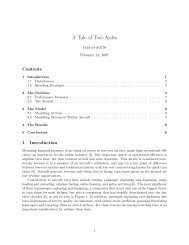Neural Models of Bayesian Belief Propagation Rajesh ... - Washington
Neural Models of Bayesian Belief Propagation Rajesh ... - Washington
Neural Models of Bayesian Belief Propagation Rajesh ... - Washington
You also want an ePaper? Increase the reach of your titles
YUMPU automatically turns print PDFs into web optimized ePapers that Google loves.
11.2 <strong>Bayesian</strong> Inference through <strong>Belief</strong> <strong>Propagation</strong> 237<br />
ability propagation) [26] that involves passing messages (probability vectors)<br />
between the nodes <strong>of</strong> the graphical model and summing over local products<br />
<strong>of</strong> messages, an operation that can be tractable. The belief propagation algorithm<br />
involves two types <strong>of</strong> computation: marginalization (summation over<br />
local joint distributions) and multiplication <strong>of</strong> local marginal probabilities. Because<br />
the operations are local, the algorithm is also well suited to neural implementation,<br />
as we shall discuss below. The algorithm is provably correct for<br />
singly connected graphs (i.e., no undirected cycles) [26], although it has been<br />
used with some success in some graphical models with cycles as well [25].<br />
11.2.1 A Simple Example<br />
We illustrate the belief propagation algorithm using the feed-or-flee problem<br />
above. The nodes R and M first generate the messages P (R) and P (M) respectively,<br />
which are vectors <strong>of</strong> length two storing the prior probabilities for<br />
R = 0 and 1, and M = 0 and 1 respectively. These messages are sent to node<br />
C. Since a cry was heard, the value <strong>of</strong> C is known (C = 1) and therefore, the<br />
messages from R and M do not affect node C. We are interested in computing<br />
the marginal probabilities for the two hidden nodes R and M. The node C<br />
generates the message mC→R = mC→M = (0, 1), i.e., probability <strong>of</strong> absence <strong>of</strong><br />
a cry is 0 and probability <strong>of</strong> presence <strong>of</strong> a cry is 1 (since a cry was heard). This<br />
message is passed on to the nodes R and M.<br />
Each node performs a marginalization over variables other than itself using<br />
the local conditional probability table and the incoming messages. For example,<br />
in the case <strong>of</strong> node R, this is <br />
<br />
M,C P (C|R, M)P (M)P (C) = M P (C =<br />
1|R, M)P (M) since C is known to be 1. Similarly, the node M performs the<br />
marginalization <br />
<br />
R,C P (C|R, M)P (R)P (C) = R P (C = 1|R, M)P (R). The<br />
final step involves multiplying these marginalized probabilities with other<br />
messages received, in this case, P (R) and P (M) respectively, to yield, after normalization,<br />
the posterior probability <strong>of</strong> R and M given the observation C = 1:<br />
<br />
<br />
P (R|C = 1) = α P (C = 1|R, M)P (M) P (R) (11.2)<br />
M<br />
<br />
<br />
P (M|C = 1) = β P (C = 1|R, M)P (R) P (M), (11.3)<br />
R<br />
where α and β are normalization constants. Note that equation (11.2) above<br />
yields the same expression for P (R = 1|C = 1) as equation (11.1) that was<br />
derived using Bayes rule. In general, belief propagation allows efficient computation<br />
<strong>of</strong> the posterior probabilities <strong>of</strong> unknown random variables in singly<br />
connected graphical models, given any available evidence in the form <strong>of</strong> observed<br />
values for any subset <strong>of</strong> the random variables.<br />
11.2.2 <strong>Belief</strong> <strong>Propagation</strong> over Time<br />
<strong>Belief</strong> propagation can also be applied to graphical models evolving over time.<br />
A simple but widely used model is the hidden Markov model (HMM) shown
















